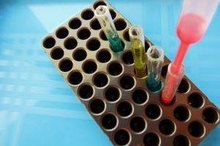What Is RDW on a Blood Test?
If your physician has diagnosed you with a type of anemia or iron deficiency, then somewhere along the line you must have had a blood test that reflected an abnormal RDW count. Your RDW levels, along with a combination of a few other important blood counts, are what help your physician figure out just what type of anemia you have, and why it has manifested. HIP Health Plan of New York explains that there are more than 400 known types of anemia, which can be further broken down into subgroups relating to blood loss, poor red-cell production and the demise of red blood cells 1.
What Does RDW Stand For?
RDW is the abbreviation for "red blood cell distribution width." According to Lab Tests Online, RDW calculates the varying sizes of red blood cell (RBC) volume in a blood sample 2. An RDW test is usually performed as part of a CBC, or complete blood count 2.
RDW and MCV
What Is MCHC in a Blood Test?
Learn More
It is virtually impossible to discuss the RDW aspect of a blood test without including MCV, or mean corpuscle value. MCV goes hand in hand with red blood cell distribution width (RDW) in terms of anemia and other hematology disorders, and the values of both are influenced by each other. For instance, low MCV levels in combination with normal RDW may point to chronic disease, while low MCV combined with low RDW can denote iron deficiency. In the same respect, a normal MCV reading in combination with normal RDW may represent a chronic disorder, and normal MCV combined with high RDW can signify a B12 deficiency. Chronolab.com also reveals that when MCV levels are high and RDW is normal, pre-leukemia may be present. Both high MCV and high RDW may mean that a patient is experiencing folate deficiency.
- It is virtually impossible to discuss the RDW aspect of a blood test without including MCV, or mean corpuscle value.
- In the same respect, a normal MCV reading in combination with normal RDW may represent a chronic disorder, and normal MCV combined with high RDW can signify a B12 deficiency.
RDW Calculation
RDW is calculated by dividing the standard deviation (SD) by the mean corpuscle volume (MCV) and then multiplying that result by 100. The standard deviation represents the volume of erythrocytes or red blood cells that are in the blood smear. According to Beckman Coulter, the equation for the RDW calculation is RDW = SD / MCV x 100.
Normal Reference Range for RDW Blood Test
What Is High RDW and Low Ferritin?
Learn More
Normal RDW values are between 11 and 14 percent, with an optimum RDW value range of 13 percent. When RDW values rise above normal levels, several disorders become suspect. According to the Archives of Internal Medicine, RDW counts may also play an important role in predicting mortality, especially in patients who have cardiovascular disease and cancer. In fact, patients who test higher than the normal reference range on an RDW test may suffer more health risks than those patients whose RDW values are lower.
- Normal RDW values are between 11 and 14 percent, with an optimum RDW value range of 13 percent.
- In fact, patients who test higher than the normal reference range on an RDW test may suffer more health risks than those patients whose RDW values are lower.
Anisocytosis
Anisocytosis is diagnosed when the RDW levels in a blood test indicate excessively high values of variably shaped red blood cells. In the book "Diagnostic Hematology," author Norman Beck explains that the presence of anisocytosis in a diagnostic blood test is so common that it is often dismissed as a component while making a diagnosis. But, breakthroughs in medicine have shed new light on the importance of anisocytosis during patient evaluation. When anisocytosis is measured against other blood cell values, the high RBC values can help make a better determination of the type of anemia present in a patient.
- Anisocytosis is diagnosed when the RDW levels in a blood test indicate excessively high values of variably shaped red blood cells.
- In the book "Diagnostic Hematology," author Norman Beck explains that the presence of anisocytosis in a diagnostic blood test is so common that it is often dismissed as a component while making a diagnosis.
Consult Your Health Care Provider
Blood tests and their results are a piece of the overall diagnostic picture and are not meant to be the sole tool used for diagnosis or prognosis of illness. Consulting with your health care provider for a full physical as well as an assessment of symptoms is the best method of understanding your blood test results 1.
Related Articles
References
- HIP Health Plan of New York: Understanding Anemia
- Lab Tests Online: Complete Blood Count
- Dugdale, A., and T. Badrick. Red Blood Cell Distribution Width (RDW)—A Mechanism for Normal Variation and Changes in Pathological States. Journal of Laboratory and Precision Medicine. 2018. 3:73.
- McPherson R., Pincus M., eds. Henry's Clinical Diagnosis and Management by Laboratory Methods. 23rd ed. St Louis, MO: Elsevier; 2017
- Patel, K., Ferrucci, L., Ershler, W., Longo, D., and J. Guralnik. Red Blood Cell Distribution Width and the Risk of Death in Middle-aged and Older Adults. Archives of Internal Medicine. 20009. 169(5):515-523.
- Skjelbakken, T., Lappegard, J., Ellingsen, T. et al. Red Cell Distribution Width is Associated with Incident Myocardial Infarction in a General Population: The Tromsø Study. Journal of the American Heart Association. 2014. 3(4):e001109.
Writer Bio
Jonae Fredericks started writing in 2007. She also has a background as a licensed cosmetologist and certified skin-care specialist. Jonae Fredericks is a certified paraeducator, presently working in the public education system.








